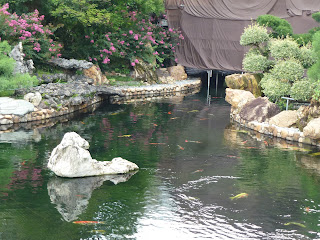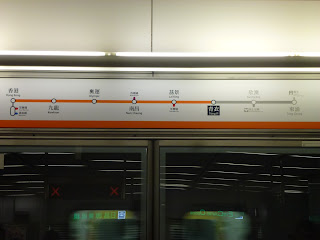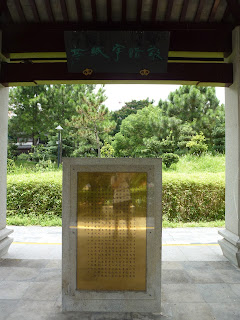Mostly photos today, but my lens was somewhat dirty... there's a tiny darker spot on every photo =.=. Anyone have any cleaning tips?
Today was the day for that Kowloon City (九龍城) trip we had been planning.
We headed out to Tsing Yi (青衣), as that was the destination of the first bus that we could catch:
Developed as a part of the Tsuen Wan New Town, most of what you see in these two photographs are reclaimed land: |
| The large bus terminus at Tsing Yi Station. |
Our next move would be at Prince Edward Station (太子站), for the Kwun Tong Line (觀塘線) into the heart of Kowloon:
 |
| Always well designed. |
so named because the area was once a quarry, and the Chinese word for drilling (鑽石) happens to be the same as the word for diamond.
The Chi Lin Nunnery (志蓮淨苑) and adjoining Nan Lian Garden (南蓮園池) are the most prominent sites to visit here:
 |
| The entrance to the gardens. |
 |
| An aerial of the complex. Gardens to the right, nunnery to the left. |
 |
| An inscription detailing the opening of the garden. |
 |
| Penzai (盆栽), the predecessor of the more well-known Japanese bonsai. (which is a planting style, not a particular cultivar) |
The Garden has a beautifully contradictory nature: one cannot help but stare at the out-of-place skyscrapers surrounding the complex.
 |
| A large koi (錦鯉) pond. |
Across the street is the nunnery itself.
 |
| That, and the ubiquitous public works projects. |
It remains a popular place of worship, with each of the main rooms housing a statue of a Bodhisattva, a Buddhist "enlightened being".
 |
| Out of respect, the nunnery asks that no photos be taken of the statues. |
After seeing the Chi Lin complex, we hop on a bus to go to the Kowloon Walled City Park (九龍寨城公園), built on the site of the old Kowloon Walled City (九龍寨城).
Again, with the towers of the city always in the distance:
 |
| ...When your plot of land is puny, there's only one thing you can do... |
But the main draw is the history behind it. In a quirk of history, when the New Territories (which then included most of what is Kowloon today) was leased to the British Empire for 99 years in 1898, the Kowloon Walled City, right in the middle of newly British territory, was never mentioned in the treaty documents. The City was a fort that Qing (清朝) China had kept right outside the tip of Kowloon that was ceded in 1842 by the Treaty of Nanking (南京條約, also in Chinese literature the first of the Unequal Treaties, 不平等條約). For years, no one knew what to do with it, until eventually, in 1933, the British decided to tear the whole fort down.
 |
| The plaque marking the opening of the park, and some of its history. |
 |
| The ruins of the old fort. |
 |
| The old sign at the gate (again, read right to left). |
 |
| The Yamen (衙門), the old officials' housing, with an interesting tree that I can't find the name of. |
 |
| For transporting important officials. |
These are the model and map of the old fort, in the exhibition area inside the Yamen.
Technically, the British still did not jurisdiction over the Walled City area, and so after the Japanese Occupation ended in 1945, thousands of people moved in, completely haphazardly. As the civil war in mainland China grew fiercer, more and more refugees moved into the City, causing it to grow enormously. At its peak, the City housed some estimated thirty-three thousand people over its 6.5 acre space, the most crowded place on Earth.
Buildings were piled on top of other buildings, and in the middle of the City, no sunlight could penetrate the endless pipes, ceilings, walls,and wires to reach the alleyways below. As it was not technically part of British Hong Kong, the colonial government felt no need to bring plumbing and electricity to the area, leaving it to basically fend for itself.
And that it did. Very quickly, a power structure arose, with the triads (三合會) eventually taking control of everything. The City became a hotbed of drug smuggling and violent crime. Neither Britain nor China wanted anything to do with it.
 |
| The famous illustrated cross-section of the City, immortalized in stone. |
 |
| Even worse than Shek Kip Mei! |
The area is right beside the old Kai Tak airport (啟德機場), and so the buildings are relatively short and old compared to the rest of the city.
Kowloon City is a sort of ethnic enclave (or as close as you can get in Hong Kong) for the Thai people, and its only mention in many of the tourist guides is as a place to eat authentic Thai.
But we came for something else:
Islam Food, a shop specializing in Xinjiang (新疆) halal dishes. Hui Muslims are a large portion of the Xinjiang population, a province-level "autonomous region" north of Tibet. They trace their ancestry to the time when the Arabic world functioned as a middleman between the Far East and the European powers. Arabic businessmen would travel in large numbers across the Silk Road, and many of them would stop and settle in China with local women.
Being Muslim, obviously, there's no pork involved anywhere. This is the restaurant's specialty:
A beef "biscuit" (牛肉餅), a pastry filled with a juicy, beefy mixture.
We then walked to the nearby wet market, which has a "cooked food centre" on the top floor.
Lok Yuen (樂園) on the left there serves up interesting twists on local favourites:Coffee/milk tea with red bean ice (鴛鴦紅豆冰). In Hong Kong, a coffee/milk tea mixture known as yuanyang is a popular beverage hot or cold. Red bean ice is a drink made from crushed azuki beans and evaporated milk. Mix them together, and you get a truly strange concoction that... doesn't taste half bad.
They also serve up french toast (西多士, lit. western toast), which locally is prepared using two slices of bread sandwiching some sweet filling, usually peanut butter.
...except here the filling is beef. Lots and lots of beef. To make satay beef french toast (沙爹牛肉西多士)
The beef is marinated and cooked in a satay sauce, giving it a slightly peanutty, savory taste that actually complements the sweetness of the french toast well. And this is strange even by the local, fusion-oriented standards. A fellow diner at the table beside ours (a local) even stared at it for a couple of minutes before asking us what the heck the thing was.
Our last stop in Kowloon City was to a high-end pastry shop (you know its high-end when they don't bother putting a Chinese name down!)
I had a passion fruit cake, with a shortcake crust, raspberry compote, and a mini macaron on top. $45 ($6CAD). Yikes. It was delicious though.
Above the buildings of Kowloon City, you can see Lion's Rock (獅子山), so named because apparently, from the right angle, it looks a lion's head. I guess not from this angle!
We hopped on a bus to the nearby Lok Fu Station (樂富站):
And rode the MTR one stop to Kowloon Tong:
Kowloon Tong (九龍塘) is the only neighbourhood not in the New Territories that has low-density housing. In the early colonial days, this was the favourite area for British officials to live, and the roads were often named for places in England. Today, it remains a favourite haunt for the wealthy in the city, with house (yes, the one time I can say "house" in Hong Kong) prices getting into the hundreds of millions of Hong Kong dollars.
It's also the location of a very nice shopping mall, Festival Walk (又一城, lit. "another city", named after the "another village" 又一村 across the street).
As with everything in Hong Kong, the lack of land means you build up, leading to some interesting architectural designs:
 |
| Stacks of escalators. |























































No comments:
Post a Comment